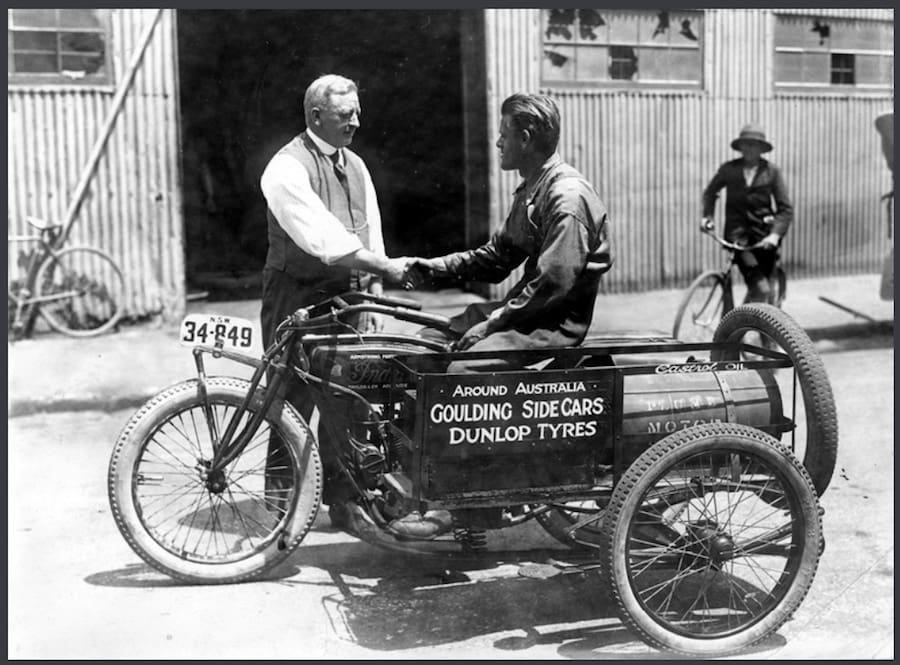Long before the term photojournalist was coined, John (‘Jack’) H Boberg convinced his literary editors at the Sydney Daily Mail that taking a year to circumnavigate Australia with his trusty Graflex camera would result in a unique thousand-image photo essay. The editors bought it.
So, using the power of the fourth estate, Boberg secured an Indian Scout complete with a custom Goulding ‘miniature masher cart’ sidecar. The odyssey would test the Indian’s reliability and so, as was expected on such occasions, Dunlop Tyres and Castrol Oils signed on. However, there’s no record of a motor spirit sponsor.
Actually, there’s no record of any forward planning at all on Boberg’s part.
His concept was to follow the coastal tracks as closely as possible and he departed Sydney on 9 December 1922, striking trouble almost immediately when the outfit tipped over between Bulli and Shellharbour and pinned him for almost an hour. But, having tamed the beast, Boberg rode on.
Crossing into Victoria, he hit the coast again at Robe and found the Coorong ‘not as bad as painted for motorcyclists’.
Given a welcome reception in Adelaide, Boberg celebrated Christmas in the City of Churches before riding north to Port Augusta. Streaky Bay went by in the sea spray off the Great Australian Bight.
Then came the isolated Telegraph Station at Eucla, shortly after which Boberg suffered a fall that severely damaged the Scout. It was a long push back to Mundrabilla Station but, we must presume, far preferable to ascending the Madura Pass on a severely wounded machine.
Boberg was pondering his position when he sighted “a queer looking object jumping over the saltbush”. This turned out to be an Aboriginal man who had removed his trousers and was waving them to signal his approach. Convinced he needed new parts for the Scout, Boberg allowed the man to guide him to the Forrest fettlers’ camp on the Transcontinental Rail Line. Temperatures ranged from 40°C at midday to below zero at midnight, and for three days Boberg existed on a loaf of bread, a tin of jam and a little bit of rancid mutton while the tribesmen dined on bandicoot basted in bulldust and thrown on the coals.
At Forrest, Boberg was able to repair his machine before following the rail line into Kalgoorlie, where he immediately aroused curiosity on account of his “travel-worn garments and luxuriant growth of whisker”. But he received generous hospitality due to him being the first motorcyclist ever to cross the Nullarbor from east to west – a seven-day journey that included his three-day walkabout.
Apparently his experiences gave Boberg no pause for thought because a fortnight later he was at the Perth Indian motorcycle distributor’s lined up for the trip north. Fortunately, he’d hit town at the same time as Jack Higham, who was on a resupply run for Glenflorrie Station just east of Onslow. The two outfits presented a unique contrast. Higham’s Indian Chief was a brand spanker, the modern sidecar fitted with tins of petrol, spare tyres, oil and supplies. Boberg’s machine, though free of the grimy mass of dirt it brought to Perth, carried only a spare tube and repair outfit.
It was noted that Boberg depended on people he came across for sustenance, one spectator remarking: “Ned Kelly was a game ’un, but he had nothing on this chap.”
The plan was for Higham to escort Boberg as far as Onslow, where the latter would keep heading north. After crossing the many rivers and creeks that rendered the coast road almost impassable, the pair reached Onslow in seven days. Shortly after leaving for Roebourne, Boberg picked up a stick in the rear wheel and skidded into a telegraph pole, damaging the Scout quite extensively.
The last report – dated April Fool’s Day 1923 – had Boberg awaiting spare parts in Onslow. He had by now run out of civilisation from which to expect a handout.
No doubt he returned safely to his home town with wondrous tales of bandicoot banquets and other bulldust. But no photo essay.

WORDS Peter Whitaker











